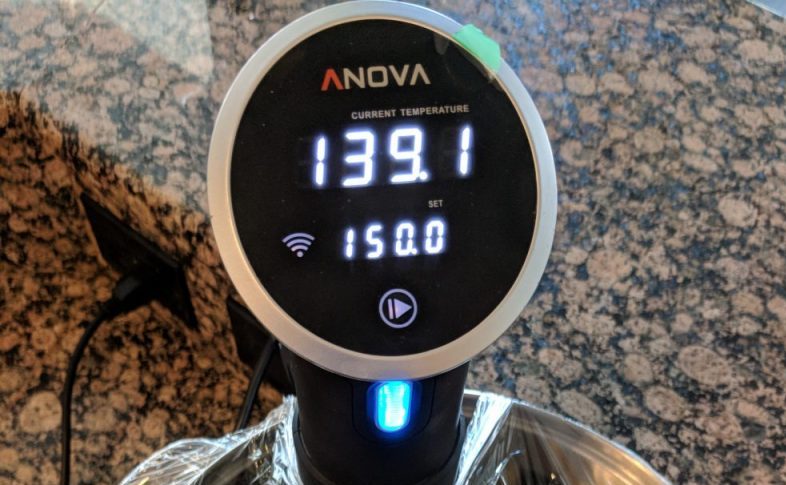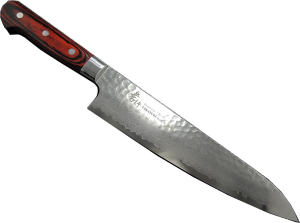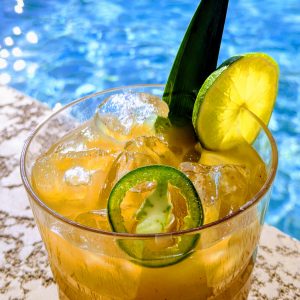What is the one of the fundamentals of all good cooking? The answer is heat. Heat for searing, baking, frying, steaming, roasting, and grilling.
Heat affects the chemistry of food. For example, in the case of meat, heat changes flavor and consistency in a complex orchestration of muscle fiber and fat. What most of us see, smell, and taste in good meat preparation comes from the external searing of protein, sugar, and high dry heat. It’s called caramelization. At the same time, a much lower inner temperature determines its doneness. The problem is that people often use the caramelization process to all achieve the inner cooking. This is the challenge of barbequing. Finding the perfect balance of external and internal heat leads to either kudos or ho-hums by those eating it.
There is an answer. It’s called Sous Vide, a cooking method that goes all the way back to the 1960s, but only recently is being re-discovered. It’s a way of precisely controlling the temperature of water into which food items can be placed for perfect cooking. Sounds logical, but putting meat in water? That doesn’t sound appetizing. Here is why it works.
Sous Vide actually means “under vacuum” in French. This is derived from the food being placed in vacuum, or near-vacuum, water-proof bags (think Food Saver or Ziploc bags) which keeps the water from touching the food, while allowing the heat of the water to reach and cook the contents.
As a cooking method, it’s become hot (sorry, bad pun). Search online and you’ll find countless websites with techniques and recipes, and yet, only a few people are using it. Why?
When I mention Sous Vide to other home cooks I can categorize their reaction into three groups:
- Avid users that swear they cook everything that way (rare),
- Hesitation by cooks that have heard about it but are afraid to try it (some), and finally,
- People that think that I’m cursing them in French (most people).
So back to the question, “Why aren’t more people using Sous Vide in their cooking?”
For the answer, I look to myself. I experimented with Sous Vide in cooking school 15 years ago. I knew about the technology and yet only started seriously cooking sous vide last year.
For starters the name is strange. How is it pronounced? What does it mean? We covered the definition earlier, so it’s no longer an excuse. As for pronunciation, think “sue veed (as in seed)”
The next obstacle has been cost. Only a few years ago, it would have required thousands of dollars to cook Sous Vide. Since then, prices have come down considerably. Today, you can buy a great quality immersion circulator (the device that heats and controls the water temperature) for under $200.
Finally, most people haven’t knowingly tasted food prepared Sous Vide, and besides, they already have their traditional cooking equipment and recipes. Does this new cooking tool make things taste better? Yes, it does, but not by introducing new flavor elements, but by precisely controlling the cooking process to maximize the elements already there.
This is extremely difficult to achieve with our pots, pans, stoves and ovens.
Sous vide is the method of cooking you have been looking for and didn’t know existed. It will cook your food better, make you look like a five-star chef, and save you money. So, with this long introduction, let me name a few reasons to get you to try it.
Precision
As I’ve said, temperature precision is the major difference between the hobbyist and the professional cook. It is also the difference between a perfectly cooked and an overdone steak. Five (5) degrees are all that separates a medium rare steak from a medium steak. Sous Vide cooking allows you to keep an exact cooking temperature for a long period of time, so the meat is slowly brought to the exact temperature needed for a desired doneness and kept there for a prolonged period of time. The steak is then quickly seared in the pan or on the grill for a perfect result. This will benefit all the different proteins you cook and is especially noticeable when cooking naturally lean meats and seafood.
Money Saving
How can Sous Vide cooking save you money, especially when you just spent another $200 for a new kitchen tool?
Think about all the seafood and meat you’ve overcooked. Never again. No more overdone steaks and rubbery shrimp. Sous Vide will excel at cooking proteins as well as vegetables, but it means even more than that. Sous Vide will make normal cuts of meat taste like prime grade beef that costs twice as much.
Let me elaborate. The different grades of meat will be determined by their tenderness and fat content. The tenderness of meat is directly related to the to the collagen contained in the muscle fiber. That collagen will be transformed to gelatin slowly, the same process that happens when we braise tough cuts of meat for a long time. When we grill a steak, we cannot keep it on the flame long enough to complete this transformation. Most of the collagen in the meat will remain unchanged as we cannot risk overcooking.
Another benefit is that the fat will start melting inside the meat, thus making it more available for our taste buds, and as you well know, fat equals flavor.
Worry Free Cooking
Hosting a large dinner party? Cooking Sous Vide will allow you to cook all the meat at the same time, and with the same degree of perfection. Sous Vide is less time sensitive and more forgiving than other methods of cooking. Were you distracted in conversation with your guest? A few minutes more in the water? No worry, nothing will be ruined.
Just last week we cooked an upscale dinner for 20 guests in a performing arts center with no kitchen. We served a beef tenderloin over brioche and wild mushroom cream sauce. Can you guess what we used? That’s right, Sous Vide.
It Is Healthier
Keeping the food at the exact required cooking temperature means more nutrients saved. Using Sous Vide also means less oil fat for cooking. Finally, with the vacuum packs, all the flavors remain in the food instead of draining away.
Look Like a Kitchen Genius
By making the perfect steak (or seafood) for your family and friends you will draw comparisons to their favorite, and expensive, steakhouse. Naturally you‘ll be asked to share your secret. Depending on how good of friends they are, you’ll be able to let them in to this cutting-edge method of cooking. Hey, look at you, the cooking expert! I can tell you that at every private dinner I cater, I always create new Sous Vide converts.
So, lots of advantages, but are there any disadvantages? Yes, life isn’t perfect. But the negatives are few and not so serious. Here they are:
Cooking in water
Water conducts heat much better than air, but the advantage of cooking in water is also a disadvantage. The maximum cooking temperature of water (not steam) is the temperature of boiling water, 212F. To sear food and get those beautiful caramelized flavors, we need to use temperatures above 300F.
The answer? A simple high heat finishing process to our Sous Vide cooked food.
No Fast Food
Cooking Sous Vide takes time and planning ahead. The food in the vacuum bags reach temperature slowly and can’t be rushed. Even shrimp will take half an hour
Hungry right now and want to eat? Look elsewhere, although some are cooking Sous Vide, finishing, and then storing. They even use Sous Vide to re-heat.
A New Cooking Method
Sous Vide is still relatively new, which means that there are less recipes created. However, the Sous Vide community has grown by leaps and bounds in the past few years and have a lot of online support. Apps for your phone with Wi-Fi and Blue Tooth make it possible for immersion circulators to almost automate cooking with easy, multiple step recipes available with a press of a button.
Convinced to use Sous Vide yet? Great. Here is the equipment you’ll need to get started. In my articles to follow, I’ll review Sous Vide equipment in greater detail as well as publish some of my favorite recipes.
Immersion Circulator
Sounds fancy, but it is just a heating element, thermostat, propeller, and a few bells and whistles. The propeller moves the water around (hence circulator), while the thermostat takes constant reads of the water temperature to decide whether the heating element should be activated. The bells and whistles include WiFi and Blue Tooth connectivity.
This particular model is my favorite. 900W of power can heat up to 5 gallons of water. I used to do 15 lbs of prime rib with one circulator. Easy to use phone applcation and also has a manual calibration in case your phone is out o reach. An easily adjustable clamp allows you to use the Anova with almost any container or cooking pot.
Sous Vide Container
You can use your immersion circulator with almost any container that can hold water and is deep enough, but it is convenient to have a dedicated container. The poly-carbonate body will retain heat better than metal container and it can withstand boiling water temperatures. The notched lid can accommodate different immersion circulators. The lid will help with temperature retention and water loss from evaporation. This particular model can hold 3 gallons of water, which should be plenty for most home applications.
Carbon Steel Pan (or Cast Iron Skillet)
After cooking meat Sous Vide you’ll need to finish it off using a smoking hot skillet. High carbon steel is very dense which means great heat retention. In layman terms it means your pan will not cool off when you place food in it and will help you create beautiful brown crust on any steak of fish. Like cast iron, carbon steel needs seasoning. If done correctly, the pan will develop a non stick surface that unlike Teflon, can withstand temperatures above 500F.
BTW, your backyard grill can be used to the same effect. Just make sure you get it hot enough.
A few more things you’ll need
You’ll need to keep the food from touching the water. I like to use a food saver vacuum packer with vacuum bags. You can also use Ziploc freezer bags and attach the top to the side of your water container with a folder clip. Make sure that the bag opening is not submerged in the water or you might have a mess on your hands.
A good food thermometer is also indispensable to esure correct cooking temperatures.
Sous Vide Cold Brew Coffee
- April 6, 2018
- snirmoraz

Experiment with different spices. Our current favorite is cardamom. Feel free to multiply the recipe. I brew 7 mason jars at a time trying to keep up with my family’s consumption…
- Prep Time5 min
- Cook Time2 hr
- Total Time2 hr 5 min
- Yield1 qt
- Course
Ingredients
- 1 qt. Filtered water
- 3/4 cup medium ground coffee
- Optional - 1/4 teaspoon cardamom grains (or any other spice)
Equipment
- Immersion circulator
- Water container
- 1 qt mason jar
- Sieve
- Coffee filter
Preparing the water bath
Fill your water container with hot tap water.
Install the immersion circulator, set the temperature to 150F.
Prepare the coffee
Place the coffee grounds in a mason jar.
Grind the spices in a spice grinder or a mortar and pestle. Add to the jar.
Add one quarter of the water to the jar. Stir with a spoon. Add more water to bring the coffee 1/2 inch from the top.
Close the mason jar, tightening the lid using only your fingertips. Careful not to over tighten the lid. You want to allow air to escape as the water heats up. If your mason jar is sealed too tightly you risk the jar cracking and a really messy water container.
Brew the coffee
Carefully lower the mason jar into the water.
Set the timer to 2 hours and go watch your favorite TV show.
After 2 hours remove the mason jar from the water. Be careful, even though the temperature is “only” 150F, it is still quite hot.
Strain the coffee through a coffee filter set in a sieve. Refrigerate and serve. Keep refrigerated in a lidded container for up to a week.
Try to use different coffees each time you brew. The low acidity in the cold brew coffee will bring out more flavors that were previously masked when you brewed it the old fashioned way. It will make you see your coffee in a different light.



